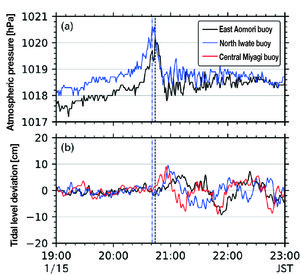Major Research Elucidation of oceanographic phenomena based on central processing and analysis of observation data
In this research, we are continuously processing and analyzing oceanographic observation data obtained by the Nationwide Ocean Wave Information Network for Ports and HArbours (NOWPHAS) to elucidate the characteristics of wave occurrence at each port, and conducting detailed analysis of the most remarkable marine oceanographic cases that occurred during the relevant year. In recent years, waves and storm surges caused by Typhoon Jebi (Typhoon No. 21) in 2018 and Typhoon Faxai (Typhoon No. 15) in 2019 caused significant damage to port facilities in Osaka Bay and Tokyo Bay, respectively. However, the waves that were observed and analyzed during 2020 indicated that no major high waves occurred along the coast of Japan, as few typhoons formed near Japan or approached it. On the other hand, as a remarkable example of oceanographic other than waves, we analyzed the tidal change (tsunami) reaching to the Pacific coast of the Tohoku region following the eruption of a submarine volcano in Tonga on January 15, 2022. As a result of the analysis, a maximum tsunami of about 106 cm was observed at the tide station at Kuji Port, and a tide level deviation occurred immediately after the rapid rise and fall in a short period, of the onboard barometer on the GPS wave buoys installed offshore, suggesting that at least the initial tide level deviation was caused by an air vibration phenomenon due to atmospheric waves, we were able to obtain valuable observation results.

Chronological changes in atmospheric pressure (a) and tidal level deviation (b)
measured by GPS wave buoys.
★The figures clearly indicate that the tidal level deviations occurred immediately
following the sudden fluctuations in atmospheric pressure.



